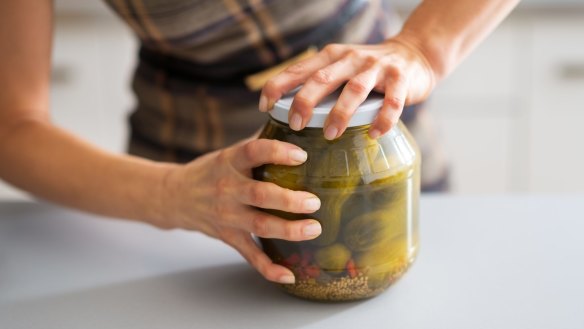What's the best way to remove the lid of a jar?

What's the best way to open a difficult jar? O. Purdey
When it comes to opening a jar of pickles with a lid that just won't budge, you need to consider two things: force and friction. To break open the seal formed by a partial vacuum when the jar was pasteurised you have to fight the planet's atmospheric pressure pushing down on the lid. Someone with big strong hands can twist off a problematic lid more easily than a person with smaller, weaker hands. They have more surface area, or skin contact, to apply greater force. You can also tap the lid firmly on a bench to help loosen the seal. Next, immerse the jar in warm to hot water for 10 minutes to expand the contents of the jar, thus partially lessening the difference between the pressure inside and outside the jar. If your hands are slipping on the lid, you can improve your grip by encircling the edge of the lid with a wide rubber band. If you don't succeed after this stuck-jar triage, you can go nuclear and destroy the airtight seal by piercing the lid with something fine and sharp such as a metal skewer.
I have been foraging and want to know how to prepare stinging nettles? L. Moore
Years ago, I was dining in Brisbane and enjoying a fresh salad. Suddenly there were a series of sharp stinging pains in my mouth. The chef had "foraged" some wild greens, some of which were nettles. The pain was intense, and my tongue swelled until it was slightly larger than Jamie Oliver's. Do not serve raw nettles. They have tiny little hollow needle-like hairs that contain formic acid, like an ant bite, that causes the pain. They also contain histamine that causes inflammation. Heat deactivates the sting. To prepare them, don rubber gloves and remove bugs, grass, and detritus. Remove the roots and thick stems if still attached. Rinse thoroughly as one would spinach. Blanch in boiling water and refresh in cold water. Use in vegetable dishes, omelettes and soup and serve with chicken and fish.
Letters
Recently we discussed the conundrum of slicing oranges finely enough for the perfect marmalade. D. Leayr suggested a perfectly honed Japanese-made kitchen knife while J. Boughton still uses a Victorian-era citrus slicer she is considering donating to a museum. I. McKenzie recommends the Japanese-made Benriner mandoline, basically a razor-sharp blade just protruding from a sheet of hard plastic. Excellent advice. C. Marley has a very interesting method in which she boils the fruit first until soft, allows to cool, and then finely slices. And Australia's best gravy quest continues with J. Lester adding that her "best gravy" starts with the juices and brown bits in the roasting pan. To this she adds a tablespoon of plain flour and stirs this into the pan over a medium heat. "I add some tomato sauce (sometimes add a dash of Worcestershire sauce too), season, add water and stir well to thicken. I never strain gravy - everyone loves the 'bits and pieces' in the gravy. Always a winner with family and friends."
Send your vexing culinary conundrums to brainfood@richardcornish.com.au or tweet or insta @foodcornish
- More:
- Food
- Brain food
